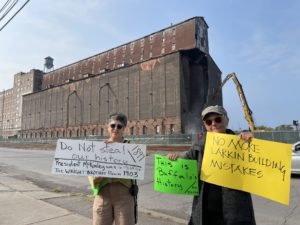By this stage in Buffalo’s economic recovery process, one would think that it would be quite obvious that preservation would be one of the single most important tried and true strategies. By preserving, and restoring this city’s historic architecture, we have seen a resurgence, there is no doubt. At the same time, we continue to watch as architectural gems slip through the cracks, as if they meant nothing. Whether we’re talking about St. Mary’s on the Hill, numerous buildings along the Genesee Gateway, or the Great Northern (lead image), this city talks a good preservation game, and then doesn’t back it up.
In order to quantify just how meaningful preservation is to Buffalo, Preservation Buffalo Niagara and the Lipsey Architecture Center Buffalo have announced the release of “Everyone’s Heritage: The Impact of Historic Preservation in Buffalo.” This is the first time that a report of this nature has been thoroughly conducted, as it relates to the economic and social impacts of historic preservation. The findings – conducted by PlaceEconomics, a firm of world-renowned economists – demonstrate that Buffalo is unique, stating: there is “no city in the United States where the historic preservation movement has had a higher priority on making sure that historic preservation is diverse, inclusive, and equitable.”
“The extraordinary collection of historic resources in Buffalo has attracted visitors worldwide and made heritage tourism a significant part of the City’s economy,” stated Donovan Rypkema, chief author of the study and Principal and Found of Place Economics. He went on to add: “Few cities in America have been more successful in making sure that historic preservation reflects the entire population than has Buffalo.”
Buffalo’s historic preservation efforts were found to play a significant role in supporting economic diversity, property values, tax revenues, jobs, and incomes.
State Senator Sean Ryan said, “The results of this study demonstrate what defenders of our city’s historic buildings have known all along. Historic preservation is about much more than keeping old buildings intact for nostalgia’s sake. A large part of Buffalo’s economic resurgence has been tied to the city’s architectural history. This report quantifies the impact historic preservation has already had on Buffalo and demonstrates just how far its benefits can reach.”
Jessie Fisher, Executive Director of Preservation Buffalo Niagara, said, “This report confirms what many of us have believed to be true, but didn’t have the numbers to prove. There can now be no doubt that historic preservation is a major part of making Buffalo a more sustainable, equitable, and successful city. We hope this report will give neighborhood leaders and politicians alike the tools to fight for the places that matter to them, because now we know that those places matter to all of us.”
Paris Roselli, Executive Director of the Lipsey Architecture Center Buffalo, said, “Western New York hosts a wealth of architectural marvels and, through the data collected in this valuable report, we can point to the importance of preserving our architectural heritage for the community. We are very pleased to have collaborated with PBN in this endeavor and grateful for the excellent work of PlaceEconomics.”
The “Everyone’s Heritage” report found that:
41,000 Buffalonians live in a historic district.Historic districts are both economically and racially diverse—neighborhoods in local historic districts were found to be more fully integrated and less segregated than neighborhoods in the rest of Buffalo. Properties in historic districts contribute a disproportionate share of the city’s property tax revenue.Property values in historic districts have increased at a rate far greater than the rest of Buffalo.Vacancy levels in local historic districts have fallen due to population growth while vacancies in the rest of the city have fallen largely through demolition of vacant or abandoned properties.Nearly half of all job growth in Buffalo took place in historic districts, even though commercial historic districts represent a tiny fraction of Buffalo’s land.Over the last decade, an average of $54 million has been invested in historic district properties.That investment has generated on average 272 direct jobs and 247 indirect jobs, totaling an averaged $15 million in labor income.Heritage tourism is a major contributor to Buffalo’s economy: 13.4% of visitors to Buffalo come for our history and architecture.More than $658 million in local spending is generated by heritage tourists each year.Heritage tourism has created 6,000 direct jobs and 2,100 indirect jobs in Buffalo.
Now that the City is privy to this report, one would think that it would take a closer look at the importance of preserving our architectural heritage. By investing in our history, we are investing in our future. Let’s stop playing politics, and start concentrating harder on preserving the historic buildings that play a key role in our city’s revival and stability.
This work was made possible with funding from the Baird Foundation, the John R. Oishei Foundation, New York State Senator Sean Ryan, and Erik Stenclik and Steven Deitz. The key findings and full report can be viewed at online at www.preservationbuffaloniagara.org/everyones-heritage.
The post Everyone’s Heritage: The Impact of Historic Preservation in Buffalo appeared first on Buffalo Rising.

